NCERT Solutions for Class 9 Science Chapter 12 Sound
NCERT Solutions for Class 9 Science (physics) Chapter 12 Sound are given below. In these solutions, we have answered all the intext and exercise questions provided in NCERT class 9 science textbook. Class 9 NCERT Solutions Science Chapter 12 provided in this article are strictly based on the CBSE syllabus and curriculum. Students can easily download these solutions in PDF format for free from our app.
Class 9 Science Chapter 12 Textbook Questions and Answers
Intext Questions and Answers
Page no: 162
Question 1: How does the sound produced by a vibrating object in a medium reach your ear?
Answer: When a body vibrates the air in its neighborhood is alternately compressed and rarefied. The compressed air has higher pressure than surrounding air. It therefore pushes the air particles near it causing compression to move forward. A rarefaction or low pressure is created at the original place. These compressions and rarefaction causes particles in the air to vibrate about their mean position. The energy is carried forward in these vibrations. This is how sound travels.
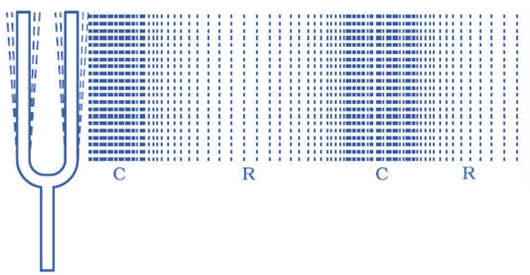
Page no-163
Question 1: Explain how sound is produced by your school bell?
Answer: When the school bell is hit with a hammer, it moves forward and backwards producing compression and rarefaction due to vibrations. This is how sound is produced by the school bell.
Question 2: Why are sound waves called mechanical waves?
Answer: Sound waves require a medium to propagate to interact with the particles present in it. Therefore, sound waves are called mechanical waves.
Question 3: Suppose you and your friend are on the moon. Will you be able to hear any sound produced by your friend?
Answer: On the moon, sound cannot travel as there is no atmosphere. Sound cannot travel in vacuum so we will not be able to hear any sound.
Page no-166
Question 1: Which waves property determines
(a) loudness
(b) pitch?
Answer: (a) Loudness is determined by the amplitude of the sound. Greater the amplitude more will be the loudness.
(b) Pitch is determined by frequency. Higher is the frequency, greater will be the pitch.
Question 2: Guess which sound has a higher pitch: guitar or car horn?
Answer: Guitar
Page no- 166
Question 1: What are wavelength, frequency, time period and amplitude of a sound wave?
Answer: Wavelength: The distances between two consecutive compressions or rarefaction of a wave. Its S.I unit is meter.
Frequency: One compression and one rarefaction constitutes one vibration. The number of vibration in a second is called frequency. Its unit is Hertz.
Amplitude: When waves are produced, the particles vibrate about their mean position. The maximum displacement from its mean position of a particle is called its amplitude. It is measured in meters.
Time period: The time taken by the wave to complete one oscillation i.e., the time between two consecutive compressions or rarefactions is called time period.
Question 2: How are the wavelength and frequency of a sound wave related to its speed?
Answer: Wavelength, speed, and frequency are related in the following way:
Speed = Wavelength × frequency
⇒ V = λ × ν
Question 3: Calculate the wavelength of a sound wave whose frequency is 220 Hz and speed is 440 m/s in a given medium.

Question 4: A person is listening to a tone of 500 Hz sitting at a distance of 450 m from the source of the sound. What is the time interval between successive compressions from the source?
Answer: The time interval between successive compressions from the source is equal to the time period and time period is reciprocal of the frequency. Therefore, it can be calculated as follows:

Page no. 166
Question 1: Distinguish between loudness and intensity of sound?
Answer: Loudness and intensity both depend upon the amplitude of sound. But loudness is the physiological response of our ears to a particular frequency. Our ears are more sensitive to some frequencies as compared to others. Intensity is the amount of sound energy passing per second per unit area. It is proportional to square of amplitude.
Page no. 167
Question 1: In which of the three media, air, water or iron, does sound travel the fastest at a particular temperature?
Answer: Sound travels faster in iron and slowest in air.
Page no-168
Question 1: An echo returned in 3 s. What is the distance of the reflecting surface from the source, given that the speed of sound is 342 ms−1 ?
Answer 1: Given, Time for echo = 3 s
v = 342 m/s
Therefore distance:
d = v × t
= 342×3 m
= 513 m.
Page No. 169
Question 1: Why are the ceilings of concert halls curved?
Answer: The ceilings of concert halls are curved so that after reflections from the surface, sound can reach each and every part of the hall.
Page no. 170
Question 1: What is the audible range of the average human ear?
Answer: 20 Hz to 20,000 Hz is the audible range of the average human ear. Any sound less than 20 Hz or greater than 20,000 Hz frequency is not audible to human ears.
Question 2: What is the range of frequencies associated with (a) Infra sound? (b) Ultrasound?
Answer: (a) Infra-sound less than 20 Hz
(b) Ultra-sound greater than 20, 000 Hz.
Page no. 172
Question 1: A submarine emits a sonar pulse, which returns from an underwater cliff in 1.02 s. If the speed of sound in salt water is 1531 m/s, how far away is the cliff?
Answer: Time (t) taken by the sonar pulse to return = 1.02 s
Speed (v) of sound in salt water = 1531 m s-1
Distance travelled by sonar pulse = Speed of sound × Time taken
= 1531 x 1.02
= 1561.62 m
Distance of the cliff from the submarine = (Total distance travelled by sonar pulse) / 2
= 1561.62 / 2
= 780.81 m.
EXERCISES
Question 1: What is sound and how is it produced?
Answer: Sound is a form of energy and it is produced due to vibrations of different types of object.
For example: A vibrating tuning fork, a bell, wires in a sitar and a guitar etc.
Question 2: Describe with the help of a diagram, how compressions and rarefactions are produced in air near a source of sound.
Answer: If we blow a horn, speak, or produce sound by an object in air we are pushing the air molecules. These molecules, in turn, push the adjacent molecules which impart their energy to the next ones. After losing energy in the interaction, the molecule is back to its original mean position. This results in formation of compressions and rarefactions.
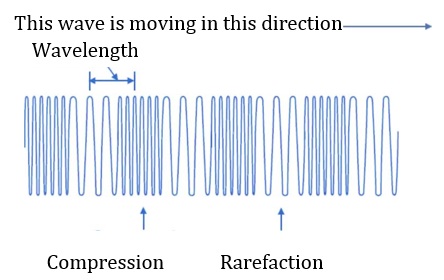
Question 3: Cite an experiment to show that sound needs a material medium for its propagation.
Answer: Take an electric bell and hang it inside an empty bell-jar which is fitted with a vacuum pump (as shown in the figure below).
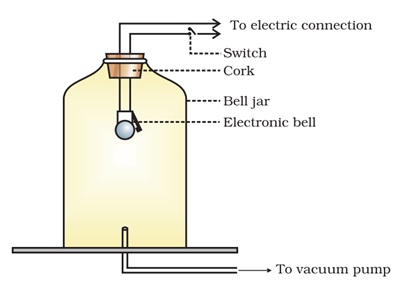
Initially, one can hear the sound of the ringing bell. Now, pump out some air from the bell-jar using the vacuum pump. You will realize that the sound of the ringing bell decreases. If you keep on pumping the air out of the bell-jar, then glass-jar will be devoid of any air after some time. Now try to ring the bell. No sound is heard but you can see bell prong is still vibrating. When there is no air present in the bell jar, a vacuum is produced. Sound cannot travel through vacuum. Therefore, this experiment shows that sound needs a material medium for its propagation.
Question 4: Why sound wave is called a longitudinal wave?
Answer: A sound wave is called a longitudinal wave because it travels in the form of compressions and rarefactions in the medium, where the particles of the medium vibrate in a direction which is parallel to the direction of propagation of the sound wave.
Question 5: Which characteristic of the sound helps you to identify your friend by his voice while sitting with others in a dark room?
Answer: Quality of sound is a characteristic that helps us identify the voice of a particular person. Two people may have the same pitch and loudness, but their qualities will be different.
Question 6: Flash and thunder are produced simultaneously. But thunder is heard a few seconds after the flash is seen, why?

Question 7: A person has a hearing range from 20 Hz to 20 kHz. What are the typical wavelengths of sound waves in air corresponding to these two frequencies? Take the speed of sound in air as 344 m-1
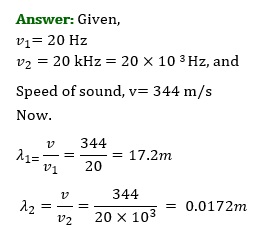
Therefore, for human beings the hearing wavelength is in the range of 0.0172 m to 17.2 m.
Question 8: Two children are at opposite ends of an aluminium rod. One strikes the end of the rod with a stone. Find the ratio of times taken by the sound wave in air and in aluminium to reach the second child.
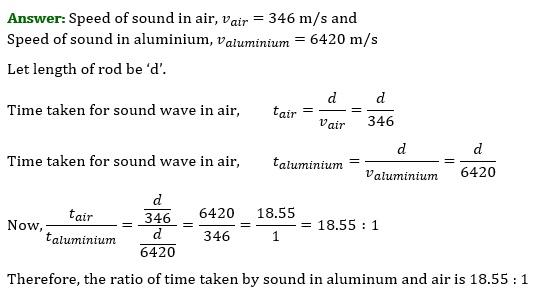
Question 9: The frequency of a source of sound is 100 Hz. How many times does it vibrate in a minute?
Answer: Since the frequency of the source of sound is 100 Hz,
Number of vibrations of the source in 1 second = 100
Number of vibrations of the source in 1 minute (i.e., 60 second) = 100 ×6 =6000
Question 10: Does sound follow the same laws of reflection as light does? Explain.
Answer: Yes. Sound follows the same laws of reflection as light. The reflected sound wave and the incident sound wave make an equal angle with the normal to the surface at the point of incidence. Also, the reflected sound wave, the normal to the point of incidence, and the incident sound wave all lie in the same plane.
Question 11: When a sound is reflected from a distant object, an echo is produced. Let the distance between the reflecting surface and the source of sound production remains the same. Do you hear echo sound on a hotter day?
Answer: In any medium as we increase the temperature the speed of sound increases. For example, the speed of sound in air is 331 m/s at 0°c and 344 m/s at 22°c. So, on a hotter day, we cannot here the echo between the same distances.
Question 12: Give two practical applications of reflection of sound waves.
Answer: The practical applications of sound are as follows:
(a) Megaphones or loud hailers are designed to send sound in a particular direction.
(b) Stethoscope are based on the principal of multiple reflection of sound within the stethoscope tube enabling the doctor to hear a patient’s heartbeat.
Question 13: A stone is dropped from the top of a tower 500 m high into a pond of water at the base of the tower. When is the splash heard at the top? Given, g = 10 ms-2 and speed of sound = 340 m/s
Answer: Height (s) of tower = 500 m
Velocity (v) of sound = 340 m s−1
Acceleration (g) due to gravity = 10 m s−1
Initial velocity (u) of the stone = 0
Time (t1) taken by the stone to fall to tower base
As per second equation of motion:
S = ut1 + (½) g(t1)2
⇒ 500 = 0 × t1 + (½) 10 (t1)2
⇒ 500 = 5(t1)2
⇒ (t1)2 = 100
⇒ t1 = 10 s
Time (t2) taken by sound to reach top from tower base
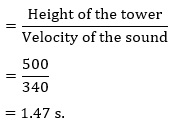
Therefore, total time (t)
t = t1 + t2
⇒ t = 10 + 1.47
⇒ t = 11.47 s.
Question 14: A sound wave travels at a speed of 339 ms-l . If its wavelength is 1.5 cm, what is the frequency of the wave? Will it be audible?
Answer: Here, Speed = 339 m s-1
Wavelength = 1.5 cm = 0.015 m
Therefore,
Frequency = Speed/Wavelength
= 339/0.013
= 22600 Hz
The frequency of audible sound for human beings lies between the ranges of 20 Hz to 20,000 Hz. The frequency of the given sound is more than 20,000 Hz, therefore, it is not audible.
Question 15: What is reverberation? How can it be reduced?
Answer: A sound created in a big hall will persist by repeated reflection from the walls until it is reduced to a value where it is no longer audible. The repeated reflection that results in this persistence of sound is called reverberation.
To reduce reverberation, the roof and walls of the auditorium are generally covered with sound-absorbent materials like compressed fibreboard, rough plaster or draperies. The seat materials are also selected on the basis of their sound absorbing properties.
Question 16: What is loudness of sound? What factors does it depend on?
Answer: The loudness (or softness) of a sound is determined by its amplitude. If amplitude is higher, it is a louder sound. It depends upon the force with which an object is made to vibrate.
Question 17: Explain how bats use ultrasound to catch a prey.
Answer: Bats can produce and hear sound of frequency up to 100 kHz. The sound produced by flying bat gets reflected from its prey in front of it. By hearing this reflected sound, it can detect the prey even during nights.
Question 18: How is ultrasound used for cleaning?
Answer: To clean any objects, it is placed in a cleaning solution and ultrasonic waves are sent into the solution. Due to the high frequency, the particles of dust, grease and dirt get detached and drop out. The objects thus get thoroughly cleaned.
Question 19: Explain the working and application of a sonar.
Answer: Sonar consists of a transmitter and a detector and is installed in a boat or a ship, as shown in following figure.
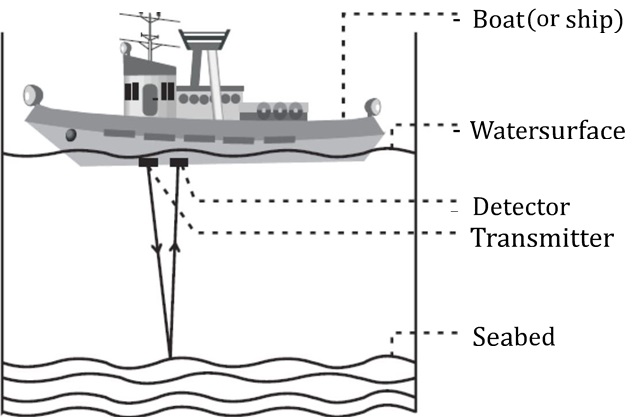
The transmitter produces and transmits ultrasonic waves. These waves travel through water and after striking the object on the seabed, get reflected back and are sensed by the detector. The detector converts the ultrasonic waves into electrical signals which are appropriately interpreted. The distance of the object that reflected the sound wave can be calculated by knowing the speed of sound in water and the time interval between transmission and reception of the ultrasound. If the time interval between transmission and reception of ultrasound signal be t and the speed of sound through seawater be v. The total distance, 201 travelled by the ultrasound is then, 2d = v × t.
The sonar technique is used to determine the depth of the sea and to locate underwater hills, valleys, submarine, icebergs, sunken ship etc.
Question 20: A sonar device on a submarine sends out a signal and receives an echo 5 s later. Calculate the speed of sound in water if the distance of the object from the submarine is 3625 m.
Answer: Total distance travelled by sound = 2 × 3625 = 7250 m
Time taken = 5 seconds
Therefore, speed = distance / time
= 7250 / 5
= 1450 m/s
So, the speed of sound in water is 1450 m/s.
Question 21: Explain how defects in a metal block can be detected using ultrasound.
Answer: Ultrasounds can be used to detect the defect in metal blocks. The cracks or holes inside the metal blocks, which are invisible from outside reduces the strength of the structure. Ultrasonic waves are allowed to pass through the metal block and detectors are used to detect the transmitted waves. If there is even a small defect, the ultrasound gets reflected back indicating the presence of the flaw or defect, as shown in following figure.
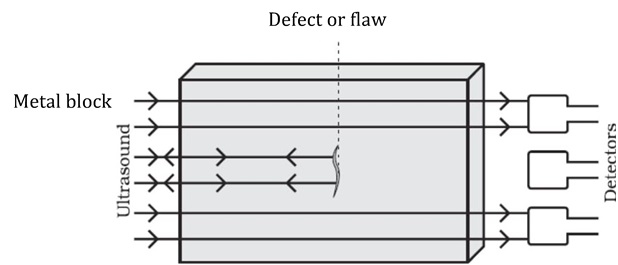
Question 22: Explain how the human ear works.
Answer:
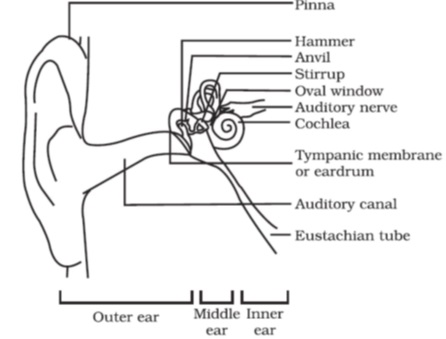
The outer ear is called ‘pinna’. It collects the sound from the surroundings. The collected sound passes through the auditory canal. At the end of the auditory canal there is a thin membrane called the ear drum or tympanic membrane. When a compression of the medium reaches the eardrum the pressure on the outside of the membrane increases and forces the eardrum inward.
Similarly, the eardrum moves outward when a rarefaction reaches it. In this way the eardrum vibrates. The vibrations are amplified several times by three bones (the hammer, anvil and stirrup) in the middle ear. The middle ear transmits the amplified pressure variations received from the sound wave to the inner ear. In the inner ear, the pressure variations are turned into electrical signals by the cochlea. These electrical signals are sent to the brain via the auditory nerve, and the brain interprets them as sound
Class 9 Science NCERT Solutions Chapter 12 Sound
CBSE Class 9 Science NCERT Solutions Chapter 12 helps students to clear their doubts and to score good marks in the board exam. All the questions are solved by experts with a detailed explanation that will help students complete their assignments & homework. Having a good grasp over CBSE NCERT Solutions for Class 9 Science will further help the students in their preparation for board exams and other competitive exams such as NTSE, Olympiad, etc.
NCERT Solutions for Class 9 Science Chapter 12 PDF
Below we have listed the topics discussed in NCERT Solutions for Class 9 Science Chapter 12. The list gives you a quick look at the different topics and subtopics of this chapter.
| Section in NCERT Book | Topics Discussed |
|---|---|
| 12.1 | Production of Sound |
| 12.2 | Propagation of Sound |
| 12.2.3 | Characteristics of a Sound Wave |
| 12.3 | Reflection of Sound |
| 12.4 | Range of Hearing |
| 12.5 | Applications of Ultrasound |